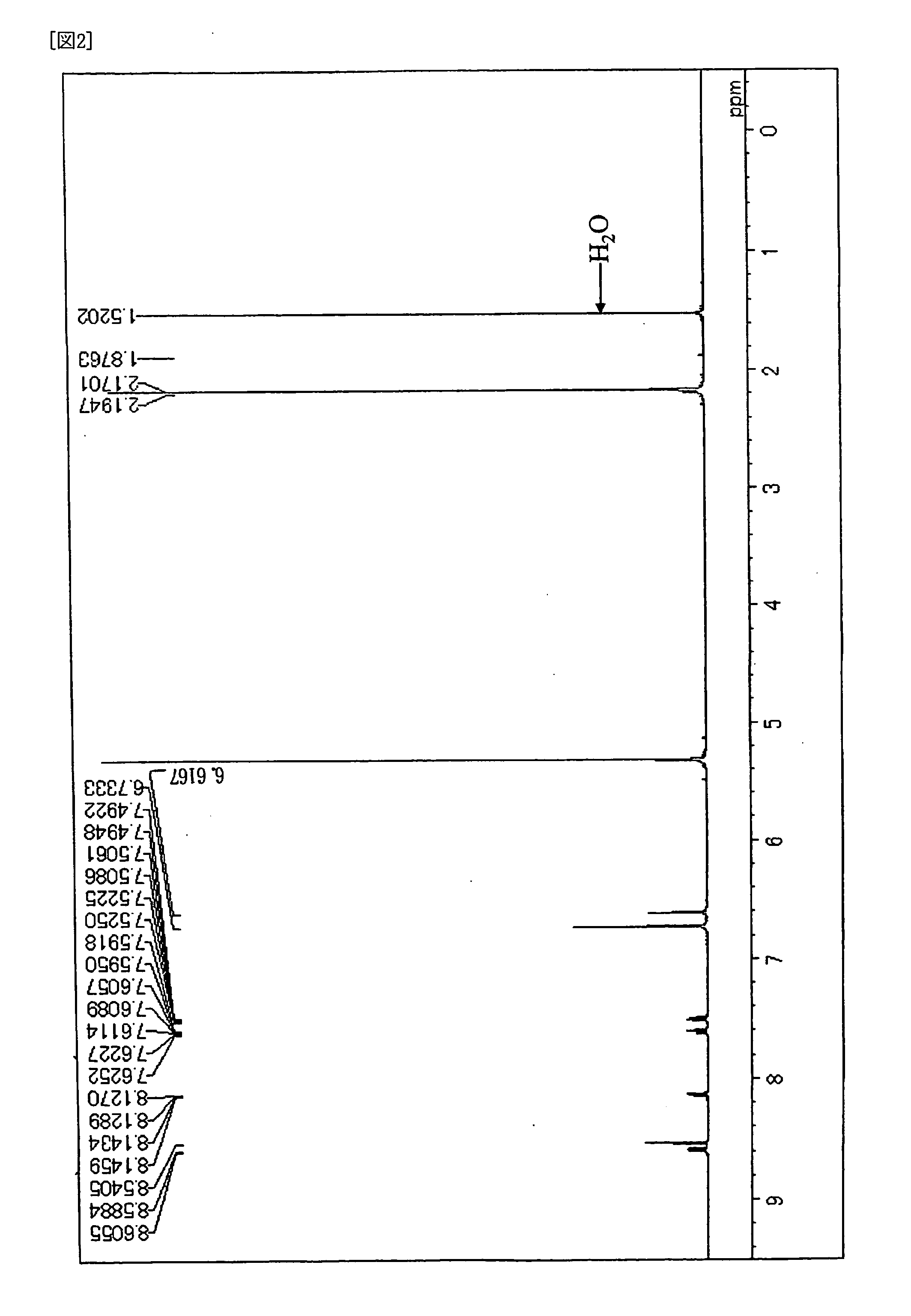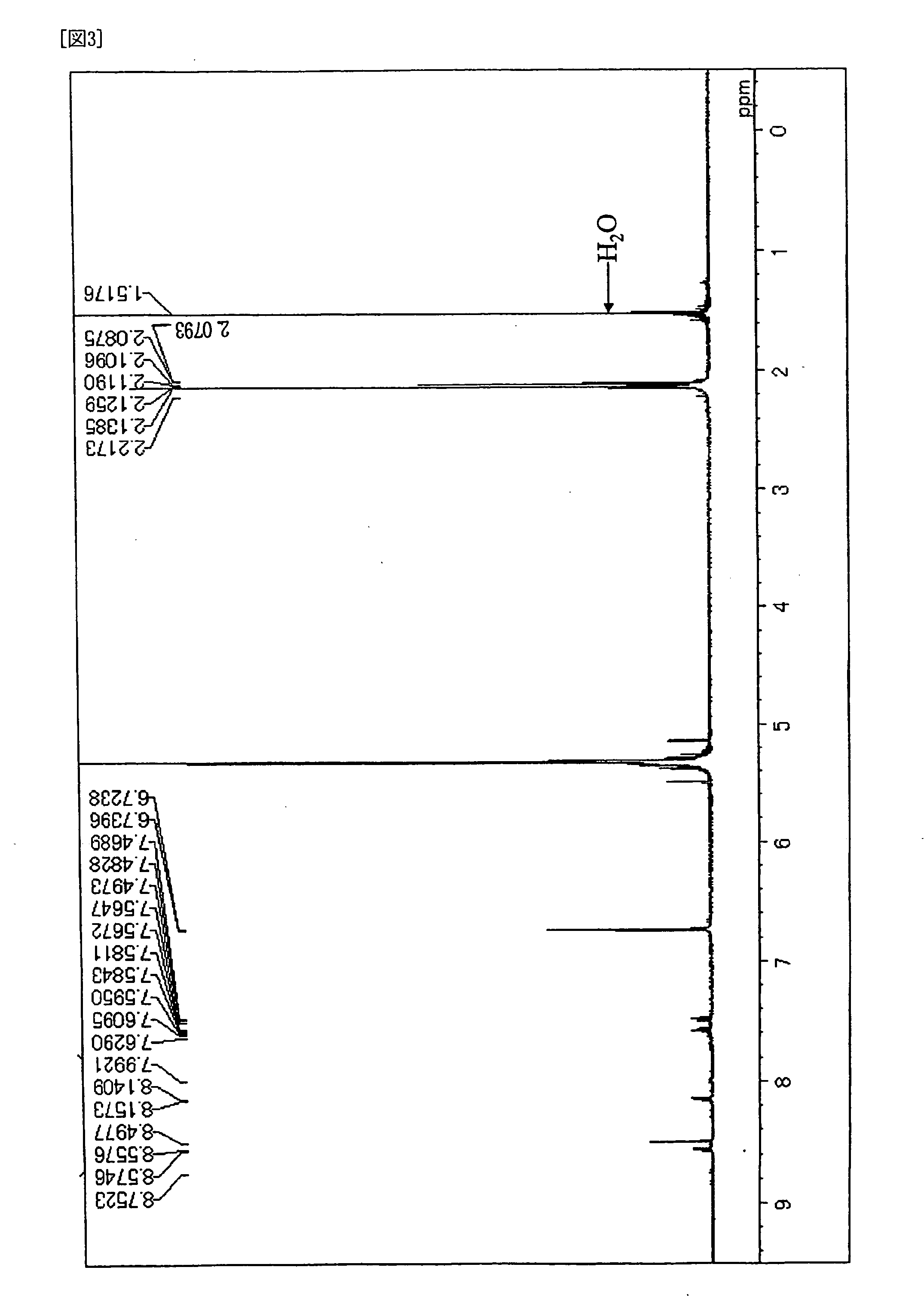Aromatic amine derivative and organic electroluminescence device using the same
an organic electroluminescence and amine technology, applied in the direction of discharge tube luminescnet screens, natural mineral layered products, etc., can solve the problems of low luminance and current efficiency, devices have not yet been put to practical use, and the driving voltage of organic el devices is higher and the lik
- Summary
- Abstract
- Description
- Claims
- Application Information
AI Technical Summary
Benefits of technology
Problems solved by technology
Method used
Image
Examples
synthesis example 1
Synthesis of Compound (D-1)
[0088] Under the atmosphere of argon gas, into a three neck flask of 300 ml equipped with a condenser, 3.8 g (10 mmol) of 6,12-dibromochrysene, 5.6 g (25 mmol) of bis(3,4-dimethylphenyl)amine, 0.03 g (1.5 mol %) of palladium acetate, 0.06 g (3 mol %) of tri-t-butylphosphine, 2.4 g (25 mmol) of t-sodiumbutoxide and 100 ml of dried toluene were placed, and then stirred over night at 100 deg C. After completion of the reaction, the crystal precipitated was separated by filtration, followed by washing it with 50 ml of toluene and 100 ml of methanol, and then 6.2 g of pale yellow powder was obtained. It was confirmed that the product was Compound (D-1) by the measurements of 1H-NMR spectrum (FIG. 1) and FD-MS (Field Desorption Mass Spectrum). Yield: 92%. The measurement of 1H-NMR spectrum was conducted by DRX-500 made by Brucker Company (heavy methylene chloride solvent). In addition, the maximum absorption wave length was 411 nm and the maximum fluorescent wa...
synthesis example 2
Synthesis of Compound (D-2)
[0089] Under the atmosphere of argon gas, into a three neck flask of 300 ml equipped with a condenser, 3.8 g (10 mmol) of 6,12-dibromochrysene, 5.6 g (25 mmol) of bis(3,4-dimethylphenyl)amine, 0.03 g (1.5 mol %) of palladium acetate, 0.06 g (3 mol %) of tri-t-butylphosphine, 2.4 g (25 mmol) of t-sodiumbutoxide and 100 ml of dried toluene were placed, and then stirred over night at 100 deg C. After completion of the reaction, the crystal precipitated was separated by filtration, followed by washing it with 50 ml of toluene and 100 ml of methanol, and then 6.6 g of pale yellow powder was obtained. It was confirmed that the product was Compound (D-2) by the measurements of 1H-NMR spectrum (FIG. 2) and FD-MS. Yield: 98%. In addition, the maximum absorption wave length was 405 nm and the maximum fluorescent wavelength was 450 nm when Compound obtained was measured in toluene solution.
synthesis example 3
Synthesis of Compound (D-9)
[0090] Under the atmosphere of argon gas, into a three neck flask of 300 ml equipped with a condenser, 3.8 g (10 mmol) of 6,12-dibromochrysene, 6.3 g (25 mmol) of bis(3,4,5-trimethylphenyl)amine, 0.03 g (1.5 mol %) of palladium acetate, 0.06 g (3 mol %) of tri-t-butylphosphine, 2.4 g (25 mmol) of t-sodiumbutoxide and 100 ml of dried toluene were placed, and then stirred over night at 100 deg C. After completion of the reaction, the crystal precipitated was separated by filtration, followed by washing it with 50 ml of toluene and 100 ml of methanol, and then 7.6 g of pale yellow powder was obtained. It was confirmed that the product was Compound (D-9) by the measurements of 1H-NMR spectrum (FIG. 3) and FD-MS. Yield: 98%. In addition, the maximum absorption wave length was 416 nm and the maximum fluorescent wavelength was 463 nm when Compound obtained was measured in toluene solution.
PUM
| Property | Measurement | Unit |
|---|---|---|
| luminance | aaaaa | aaaaa |
| work function | aaaaa | aaaaa |
| light transmittance | aaaaa | aaaaa |
Abstract
Description
Claims
Application Information
 Login to View More
Login to View More - R&D
- Intellectual Property
- Life Sciences
- Materials
- Tech Scout
- Unparalleled Data Quality
- Higher Quality Content
- 60% Fewer Hallucinations
Browse by: Latest US Patents, China's latest patents, Technical Efficacy Thesaurus, Application Domain, Technology Topic, Popular Technical Reports.
© 2025 PatSnap. All rights reserved.Legal|Privacy policy|Modern Slavery Act Transparency Statement|Sitemap|About US| Contact US: help@patsnap.com



